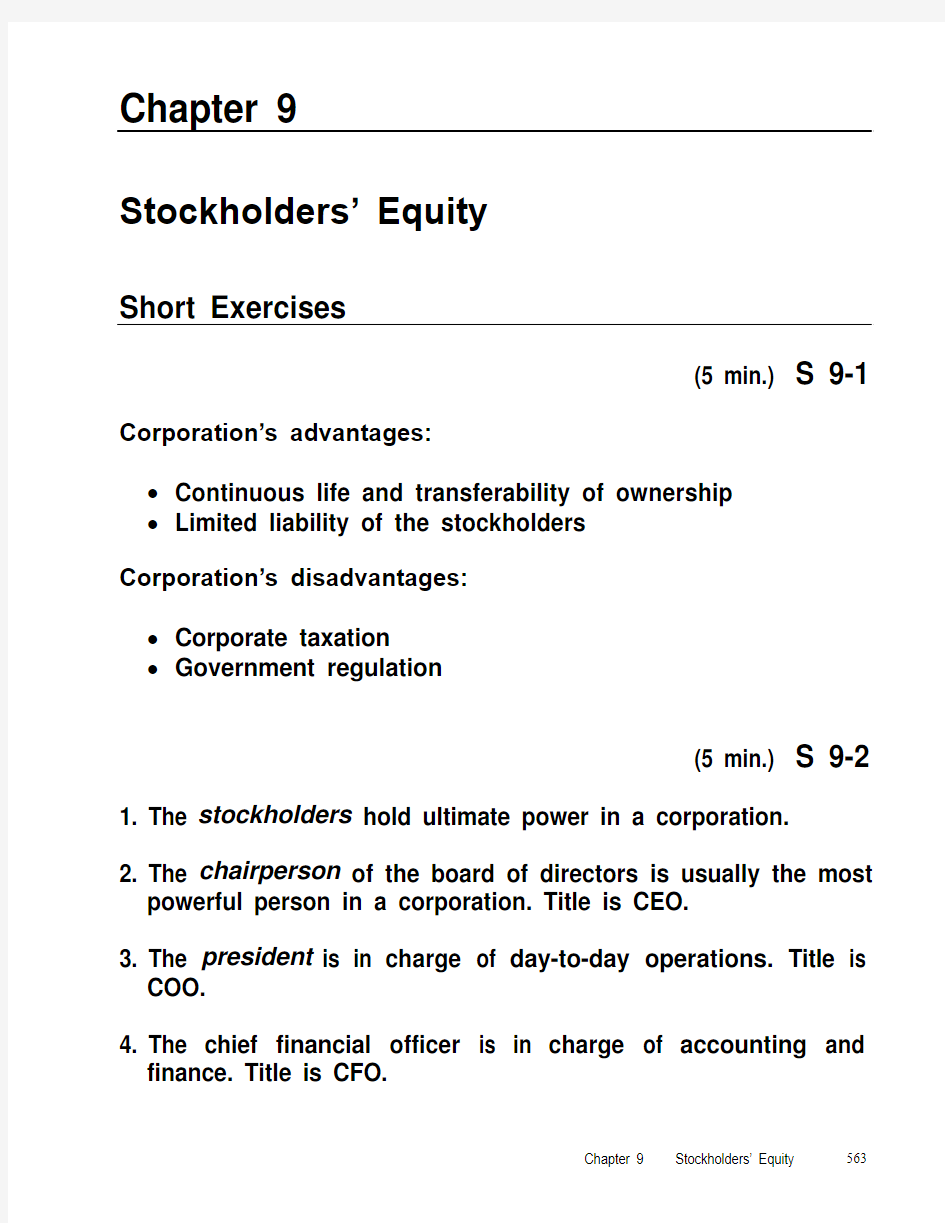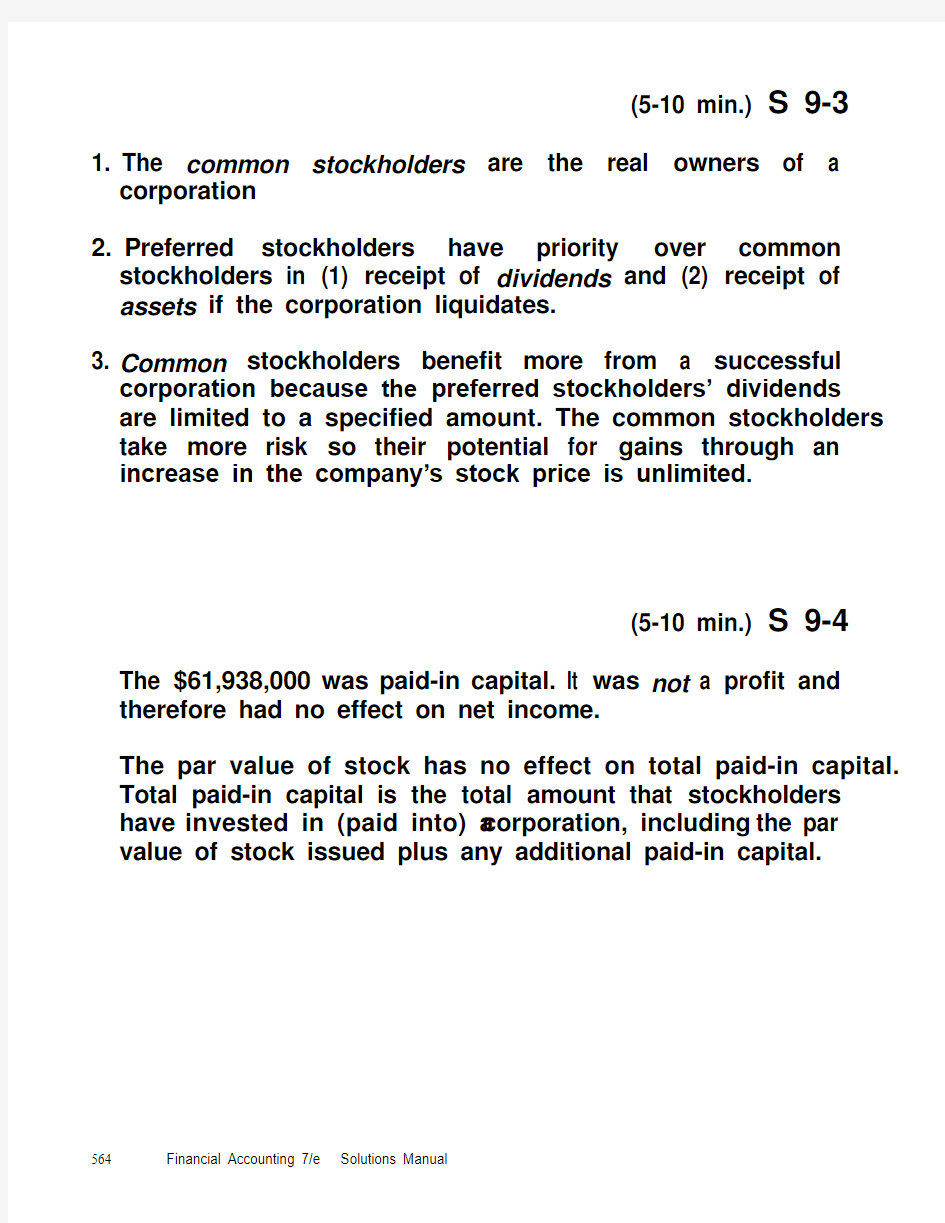

Chapter 9
Stockholders’ Equity
Short Exercises
(5 min.) S 9-1 Corporation’s advantages:
?Continuous life and transferability of ownership
?Limited liability of the stockholders
Corporation’s disadvantages:
?Corporate taxation
?Government regulation
(5 min.) S 9-2
1. The stockholders hold ultimate power in a corporation.
2. The chairperson of the board of directors is usually the most
powerful person in a corporation. Title is CEO.
3. The president is in charge of day-to-day operations. Title is
COO.
4. The chief financial officer is in charge of accounting and
finance. Title is CFO.
(5-10 min.) S 9-3 1. The common stockholders are the real owners of a
corporation
2. Preferred stockholders have priority over common
stockholders in (1) receipt of dividends and (2) receipt of assets if the corporation liquidates.
3. Common stockholders benefit more from a successful
corporation because the preferred stockholders’ dividends are limited to a specified amount. The common stockholders take more risk so their potential for gains through an increase in the company’s stock price is unlimited.
(5-10 min.) S 9-4 The $61,938,000 was paid-in capital. It was not a profit and therefore had no effect on net income.
The par value of stock has no effect on total paid-in capital.
Total paid-in capital is the total amount that stockholders have invested in (paid into) a corporation, including the par value of stock issued plus any additional paid-in capital.
(10 min.) S 9-5
Millions Hewlett-Packard:
Cash....................................................17,993 Common Stock. (27)
Additional Paid-in Capital………………..17,966 Krispy Kreme Doughnuts:
Cash (298)
Common Stock (298)
(10 min.) S 9-6 Case A — Issue stock and buy the assets in separate
transactions:
Journal
DATE ACCOUNT TITLES AND EXPLANATION DEBIT CREDIT Cash……………………………………….. 200,000
Common Stock (10,000 ×$5)……..... 50,000
Paid-in Capital in Excess of Par……150,000 Issued stock.
Building……………………………………160,000
Equipment…………………………………40,000
Cash…………………………………….. 200,000 Purchased plant assets.
Case B — Issue stock to acquire the assets:
Journal
DATE ACCOUNT TITLES AND EXPLANATION DEBIT CREDIT
B uilding……………………………………160,000
Equipment………………………………... 40,000
Common Stock (10,000 ×$5)……….50,000
Paid-in Capital in Excess of Par…... 150,000 Issued stock to acquire building and equipment.
The balances in all accounts are the same:
Building…………………………………… $160,000
Equipment……………………………….… 40,000
Common Stock…………………………... 50,000
Paid-in Capital in Excess of Par……… 150,000
(5-10 min.) S 9-7
Thousands Stockholders’ equity:
Common stock, $.01 par, 600 million shares
issued......................................................$ 6 Paid-in cap ital in excess of par.. (198)
Ret ained earnings (646)
Other s tockholders’ equity (29)
Total st ockholders’ equity………………………... $821
(10 min.) S 9-8
Thousands a. Total revenu es……………………………………….. $1,390
Total expenses (805)
Net income………………………………….………… $ 585 b. A ccounts payable…………………………………… $ 420
Other c urrent liabilities.................................... 2,566 Long-term liabilities. (25)
Tot al liabilities………………………………………... $3,011 c. Total liabilities (from Req. b)………………………. $3,011
Total stockhol ders’ equity (from S 9-7) (821)
Total assets…………………………………………… $3,832
(5 min.) S 9-9
Journal
DATE ACCOUNT TITLES AND EXPLANATION DEBIT CREDIT
Millions Treasury Stock (28)
Cash (28)
Cash (7)
Treasury Stock (3)
Paid-in Capital from Treasury Stock
Transactions (4)
Overall, stockholders’ equity decreased by $21 million ($28 million paid out minus $7 million received).
(10 min.) S 9-10
Journal
DATE ACCOUNT TITLES AND EXPLANATION DEBIT CREDIT 20X6
Dec. 15 Retained Earnings
($100,000 × .05) + (25,000 × $.60)…..20,000
Dividends Payable…………………20,000 Declared a cash dividend……………
20X7
Jan. 4 Dividends Payable……………………20,000
Cash………………………………….20,000 Paid the cash dividend.
During 20X6, Retained Earnings increased by $50,000 (net income of $70,000 ? dividends of $20,000).
(5-10 min.) S 9-11
1. $150,000 (100,000 shares × $1.50 per share)
2. Preferred: $150,000
Common: $150,000
3. Cumulative, because it is not labeled noncumulative
4. Preferred: $450,000 ($150,000 × 3)
Common: $350,000 ($800,000 ? $450,000)
(5-10 min.) S 9-12 Req. 1
Journal
DATE ACCOUNT TITLES AND EXPLANATION DEBIT CREDIT May 11 Retained Earnings (60,000 × .10 × $11.50)……69,000
Common Stock (60,000 × .10 × $1)………... 6,000
Paid-in Capital in Excess of Par-Common.. 63,000
Req. 2
No effect on total assets.
No effect on total liabilities.
No effect on total stockholders’ equity.
(10 min.) S 9-13 Total stockholders’ equity…………………………….. $4,000,000 Less: Preferred stock………………………………….(330,000) Preferred dividends in arrears
(300,000 × .08 × 3)…………………………… (72,000) Common equity………………………………………….$3,598,000 Number of common shares outstanding
(60,000 ?1,400)……………………………………….. ÷ 58,600 Book value per share of common stock……………. $ 61.40
(5-10 min.) S 9-14 (a) Rate of return
on total assets =
Net income + Interest expense
Average total asssets
(b) Rate of return
on common
= Net income ? Preferred dividends
stockholders' Average common stockholders’ equity
equity
1. Creditors have loaned money to the company and earn
interest. Stockholders have invested in the corporation’s stock and thus ow n the company’s net income. The sum of interest expense plus net income is the return to the two groups that have financed the company’s assets.
2. Preferred stockholders have the first claim to the company’s
net income through preferred dividends. Therefore, preferred dividends are subtracted from net income to compute ROE.
(10-15 min.) S 9-15
Rate of return on total
assets
Net Interest
=
income + expense
=
¥124 + ¥29 Average total assets (¥9,499 + ¥10,608) / 2
=
¥153
= 1.5%
¥10,054
Note: 10% is considered good in most industries. Therefore, Sony’s 1.5% return on assets is very weak.
Rate of return Net Preferred
on common
= income ? dividends
=
¥124 ? ¥0
stockholders’Average common (¥3,204 + ¥2,870) / 2 equity stockholders’ equity
=
¥124
= 4.1% ¥3,037
Note: 15% is considered good in most industries, so Sony’s return on equity is very weak.
(5-10 min.) S 9-16
Billions Cash flows from financing activities:
Paid off long-term notes payable……………………. $(2.7)
I ssued common stock…………………………………. 1.2
Pur chased treasury stock…………………………….. (3.0) Paid cash dividends……………………………………(1.9)
Exercises
(5-10 min.) E 9-17 DATE: _____________
TO: Lance Brown and Monica Kobelsky
FROM: Student Name
RE: Steps in forming a corporation
The first step in organizing a corporation is to obtain a charter from the state. The charter authorizes the corporation to issue a certain number of shares of stock to the owners of the business, who are called stockholders. The incorporators (Brown and Kobelsky) will need a set of bylaws to determine how the corporation is to be governed internally. The stockholders will elect a board of directors who in turn appoint officers to manage the corporation on a day-to-day basis.
Student responses may vary.
(10-15 min.) E 9-18 Req. 1
Journal
DATE ACCOUNT TITLES AND EXPLANATION DEBIT CREDIT
July 19 Cash (10,000 ×$6.50)…………………65,000
Common Stock (10,000 × $2.50) .. 25,000
Paid-in Capital in Excess of
Par - Common ............................. 40,000
Oct. 3 Cash .................................................... 50,000
Preferred Stock ............................. 50,000
11 Inventory ............................................. 11,000
Equipment ........................................... 8,500
Common Stock (3,300 × $2.50) .... 8,250
Paid-in Capital in Excess of
Par - Common ............................. 11,250
Req. 2
Stockholders’ equity:
Preferred stock, $1.50, no par
5,000 shares authorized, 500 shares issued………$50,000 Common stock, $2.50 par,
100,000 shares authorized, 13,300 shares issued…33,250 Paid-in capital in excess of par-common
($40,000 + $11,250)……………………………………….51,250 Retained earnings (deficit)………………………….…… (42,000) Total stockholders’ equity……………………….…… $92,500
(10-15 min.) E 9-19
Stoc kholders’ Equity
Preferred stock, $4.50 no-par, 5,000 shares
authorized, 300 shares issued ................................. $ 20,000 Common stock, $1 par, 10,000 shares authorized,
4,000 shares issued .................................................. 4,000 Paid-in capital in excess of par - common .................. 70,000* Retained earnings .......................................................... 49,000 Total stockholders’ equity $143,000 _____
*Computation:
June 23: 1,000 shares × ($16 ?$1) =……………………………. $15,000 July 12: $15,000 + $43,000 ? (3,000 shares × $1.00) =………. 55,000
$70,000 Journal entries (not required):
June 23 Cash……………………………………... 16,000
Common Stock ............................... 1,000
Paid-in Capital in Excess of Par…15,000
July 2 Cash ..................................................... 20,000
Preferred Stock .............................. 20,000
12 Inventory .............................................. 15,000
Equipment ............................................ 43,000
Common Stock ............................... 3,000
Paid-in Capital in Excess of Par…55,000
(10 min.) E 9-20 Paid-in capital consists of:
Preferred equity:
Issued for cash (5,000 shares × $110) ........... $550,000 Common equity:
Issued for cash (20,000 shares × $15)……... 300,000 Issued for organizing the corporation 20,000 Issued for patent……………………………….. 80,000 Total paid-in capital……………………………………$950,000 Unused data:
Net income
Dividends declared
Short-cut solution (also okay):
1. $ 20,000
2. 80,000
3. 550,000 (5,000 × $110)
4. 300,000 (20,000 × $15)
$950,000 = Total paid-in capital
(10-15 min.) E 9-21 Stockholders’ Equity (Thousands)
Common stock, $0.25 par, 800 shares
authorized, 360 shares issued........................... $ 90 Paid-in capit al in excess of par (901)
Retained earning s................................................ 2,202 Other sto ckholders’ equity (729)
Less: Treasury stock, common, 120 shares at cost.. (1,380) Total s tockholders’ equity…………………………... $1,084
Sagebrush paid a higher price to acquire treasury stock than the price Sagebrush received when it issued its stock. This explains why Treasury Stock has a greater balance than the sum of Common Stock plus Paid-in Capital in Excess of Par.
(10-15 min.) E 9-22
Journal
DATE ACCOUNT TITLES AND EXPLANATION DEBIT CREDIT
Apr. 19 Cash (2,000 ×$5)…………………………. 10,000
Common Stock (2,000 ×$1)……….... 2,000
Paid-in Capital in Excess of Par…….8,000
To issue common stock.
July 22 Treasury Stock - Common (900 × $7).... 6,300
Cash……………………………………...6,300 To purchase treasury stock.
Nov. 11 Cash (800 ×$12)…………………………... 9,600
Treasury Stock - Common (800 × $7) 5,600
Paid-in Capital from Treasury
Stock Transactions………………..4,000 To sell treasury stock.
Overall effect on stockholders’ equity
($10,000 ?$6,300 + $9,600)……………………………… $13,300
(10 min.) E 9-23
Journal
DATE ACCOUNT TITLES AND EXPLANATION DEBIT CREDIT
Millions b. Cash (6 million × $12.50) (75)
Common Stock (6 million ×$1.50) (9)
Capital in Excess of Par Value (66)
c. Treasury Stock (14)
Cash (14)
d. Retained Earnings (30)
Dividends Payabl e (30)
Dividends Payable (30)
Cash (30)
or one entry only:
Retained Earnings (30)
Cash (30)
(10 min.) E 9-24
Dollars
in
Millions Stockholders’ Equity:
Common stock, $1.50 par value,
1,806 million shares issued ($2,700 + $9)...........$ 2,709 Capital in excess of par value ($8,100 + $66).......... 8,166 Retained earnings ($1,200 + $440 ? $30)................ 1,610 Treasury stock, 1 million shares at cost. (14)
Total stockholders’ equity…………………………..$12,471